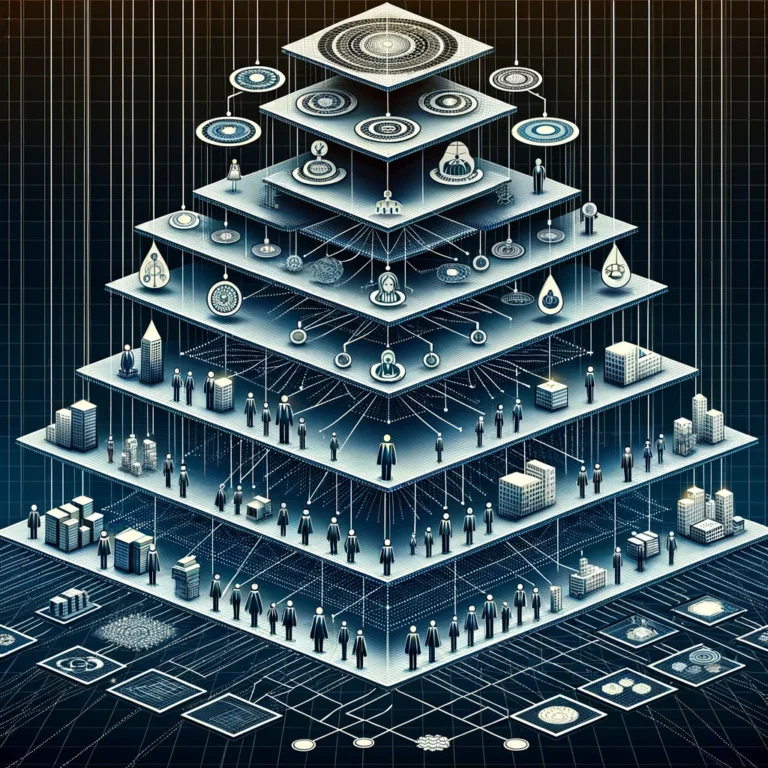Organizational structure is a critical aspect of business management, shaping how a company allocates its resources, processes information, and makes decisions. It determines the hierarchy of authority, the flow of information, and the framework within which the company operates. This comprehensive analysis delves into the key components of organizational structure: levels of hierarchy, chain of command, span of control, delegation, centralization, decentralization, bureaucracy, and de-layering. Each of these elements plays a vital role in defining the efficiency and effectiveness of an organization, as illustrated through industry examples relevant to IB Business & Management studies.
Levels of Hierarchy
Definition: This refers to the layers of authority within an organization, from the top level (e.g., CEO) to the bottom level (e.g., entry-level employees).
Industry Example: In multinational corporations like Samsung, the levels of hierarchy are clearly defined, from the CEO at the top to various levels of management and operational staff, ensuring a clear distribution of responsibilities.
Chain of Command
Definition: The formal path through which decisions flow from the highest to the lowest levels in an organization.
Industry Example: The U.S. military operates under a strict chain of command, ensuring that orders from generals reach soldiers through a well-defined path, minimizing confusion and ensuring operational integrity.
Span of Control
Definition: Refers to the number of subordinates a manager directly oversees. A wide span of control means a manager supervises many employees, whereas a narrow span signifies closer supervision of fewer subordinates.
Industry Example: In startups like SpaceX, early stages often see a wider span of control, with key leaders directly managing large teams to accelerate growth and innovation.
Delegation
Definition: The process of assigning decision-making authority to lower-level employees while retaining ultimate responsibility for the outcomes.
Industry Example: In companies like 3M, delegation is encouraged to foster innovation, allowing employees the freedom to develop new products and solutions while maintaining alignment with company goals.
Centralization
Definition: Decision-making authority is concentrated at the top levels of management, with lower levels having little autonomy.
Industry Example: In tightly controlled sectors like pharmaceuticals, companies such as Pfizer may centralize decisions to navigate complex regulatory environments efficiently.
Decentralization
Definition: Decision-making authority is dispersed throughout the organization, allowing lower levels more autonomy in their operations.
Industry Example: The Coca-Cola Company practices decentralization by giving its global bottling partners and regional divisions autonomy to respond to local market conditions.
Bureaucracy
Definition: A system emphasizing rules, procedures, and a clear hierarchy to maintain order and efficiency. High bureaucracy means many rules and structured ways of doing things.
Industry Example: Government agencies often exhibit high levels of bureaucracy, emphasizing standardized procedures and protocols to ensure consistency and fairness in public service delivery.
De-layering
Definition: The process of removing one or more levels of hierarchy to flatten the organizational structure, intended to reduce costs and improve decision-making speed.
Industry Example: HP Inc. underwent significant de-layering, reducing management levels to improve agility and reduce operational costs, aiming to foster a more collaborative and efficient organizational structure.
Types of organisational structures
Tall Organizational Structure
Characteristics: Characterized by multiple layers of management between frontline employees and top management, tall structures have narrow spans of control and long chains of command, which often result in centralized decision-making and limited delegation.
Advantages:
- Clear lines of authority and responsibility.
- Greater opportunities for advancement.
Disadvantages:
- Communication can be slower and more cumbersome.
- Innovation may be stifled due to the bureaucratic nature.
Industry Example: Many government agencies exhibit tall structures, where the necessity for clear authority and accountability necessitates multiple layers of hierarchy.
Flat Organizational Structure
Characteristics: Flat structures have few hierarchical levels, wide spans of control, shorter chains of command, decentralized decision-making, and increased delegation, making them common in small businesses and startups.
Advantages:
- Faster communication and decision-making.
- Higher employee morale due to closer interaction with management.
Disadvantages:
- Managers may become overburdened due to wider spans of control.
- May be challenging to maintain as the organization grows.
Industry Example: Tech startups like Valve operate with very flat structures, promoting innovation, flexibility, and rapid decision-making.
Organizational Structure by Hierarchy
Description: This traditional representation shows the pyramid-like chain of command within a business, from senior managers at the top to workers at the bottom.
Industry Example: Large corporations, such as General Motors, often utilize hierarchical structures to organize their vast numbers of employees, delineating clear paths of authority and responsibility.
Organizational Structure by Function
Characteristics: Employees are grouped based on their functional roles (e.g., marketing, finance, HR), fostering specialization and efficiencies within specific areas of expertise.
Advantages:
- Enhanced operational efficiency due to specialization.
- Clear career paths within functions.
Disadvantages:
- Potential for silos, leading to communication barriers between departments.
- May limit flexibility and responsiveness to market changes.
Industry Example: Most traditional manufacturing companies, like Ford Motor Company, are organized functionally to optimize operations within specialized departments.
Organizational Structure by Product
Characteristics: The workforce is divided based on specific products or product lines, facilitating focus and adaptability in product development and management.
Advantages:
- Enables focused product development and marketing strategies.
- Facilitates accountability and performance assessment for product lines.
Disadvantages:
- Duplication of functions across product lines can increase costs.
- Coordination between different product divisions can be challenging.
Industry Example: Procter & Gamble operates with a product-based structure, allowing for dedicated teams to focus on the development and marketing of diverse consumer goods.
Organizational Structure by Region
Characteristics: Ideal for businesses operating in different geographical locations, this structure allows for tailored approaches to different markets, addressing regional demands and operational challenges.
Advantages:
- Allows for customization of products and marketing strategies to fit local markets.
- Enhances responsiveness to regional market conditions and regulations.
Disadvantages:
- Can lead to complexity in coordination and consistency across regions.
- Potential for inefficiencies due to duplication of roles in different regions.
Industry Example: Coca-Cola uses a regional structure to manage its global operations, enabling it to adapt its product offerings and marketing strategies to meet the tastes and preferences of local markets effectively.
Frequently Asked Questions
What is an organisational structure in business?
An organisational structure defines how job tasks are formally divided, grouped, and coordinated within a business. It's essentially a system that outlines hierarchies, roles, responsibilities, and lines of communication, ensuring that different parts of the company work together effectively towards common goals.
What are the different organisational structures in a business?
Businesses can adopt various structures depending on their size, industry, and goals. Common types include:
- Functional/Hierarchical: Organised by departments (e.g., Marketing, Sales, HR) with clear lines of authority.
- Divisional: Grouped by products, services, geographical markets, or customer types.
- Matrix: Combines functional and project structures, with employees reporting to multiple managers.
- Flat: Features few or no levels of management, aiming for direct communication.
- Team-based: Structured around cross-functional teams working on specific projects.
- Network: Relies on outsourcing functions and collaborating with external partners.
What is a matrix organisational structure in business?
A matrix structure is a hybrid model where employees typically report to two managers: a functional manager (e.g., Head of Engineering) and a project or product manager. This structure is often used in projects or companies that require skills from different functional areas to be shared across multiple teams or projects simultaneously. While it promotes resource sharing and communication, it can sometimes lead to confusion due to dual reporting lines.
What is a tall organisational structure in business?
A tall organisational structure, also known as a hierarchical structure, is characterised by having many layers of management between the top leadership and entry-level employees. Each manager has a narrow span of control (overseeing fewer subordinates). While this can provide clear reporting lines and opportunities for promotion, it can also lead to slower decision-making, potential communication bottlenecks, and a sense of distance between upper management and the front lines.






